Antihistamines for motion sickness
- PMID: 36250781
- PMCID: PMC9575651
- DOI: 10.1002/14651858.CD012715.pub2
Antihistamines for motion sickness
Abstract
Background: Motion sickness is a syndrome that occurs as a result of passive body movement in response to actual motion, or the illusion of motion when exposed to virtual and moving visual environments. The most common symptoms are nausea and vomiting. Antihistamines have been used in the management of motion sickness for decades, however studies have shown conflicting results regarding their efficacy.
Objectives: To assess the effectiveness of antihistamines in the prevention and treatment of motion sickness in adults and children.
Search methods: The Cochrane ENT Information Specialist searched the Cochrane ENT Register; Central Register of Controlled Trials; Ovid MEDLINE; Ovid Embase; Web of Science; ClinicalTrials.gov; ICTRP and additional sources for published and unpublished trials. The date of the search was 7 December 2021.
Selection criteria: Randomised controlled trials (RCTs) in susceptible adults and children in whom motion sickness was induced under natural conditions such as air, sea and land transportation. We also included studies in which motion sickness was induced under experimental conditions (analysed separately). Antihistamines were included regardless of class, route or dosage and compared to no treatment, placebo or any other pharmacological or non-pharmacological interventions.
Data collection and analysis: We used standard Cochrane methods. Our primary outcomes were 1) the proportion of susceptible participants who did not experience any motion sickness symptoms; 2) the proportion of susceptible participants who experienced a reduction or resolution of existing symptoms. Secondary outcomes were 1) physiological measures (heart rate, core temperature and gastric tachyarrhythmia (electrogastrography)) and 2) adverse effects (sedation, impaired cognition, blurred vision). We used GRADE to assess the certainty of the evidence for each outcome.
Main results: We included nine RCTs (658 participants). Studies were conducted across seven countries, with an overall age range of 16 to 55 years. Motion sickness was induced naturally in six studies and experimentally in four studies (rotating chair). All the naturally induced studies only evaluated first-generation antihistamines (cinnarizine and dimenhydrinate). Risk of bias across the studies varied, with mostly low risk for random sequence generation and allocation concealment, and mostly high risk for selective reporting. Only the experimentally induced studies measured physiological parameters and only the naturally induced studies evaluated adverse effects. There were no studies that clearly assessed the paediatric population. Antihistamines versus placebo or no treatment Antihistamines are probably more effective than placebo at preventing motion sickness symptoms under natural conditions (symptoms prevented: 25% placebo; 40% antihistamines) (risk ratio (RR) 1.81, 95% confidence interval (CI) 1.23 to 2.66; 3 studies; 240 participants) (moderate-certainty). The evidence is very uncertain about the effect of antihistamines on preventing motion sickness under experimental conditions (standardised mean difference (SMD) 0.32, 95% CI -0.18 to 0.83; 2 studies; 62 participants) (very low-certainty). No studies reported results on the resolution of existing motion sickness symptoms. Antihistamines may result in little or no difference in gastric tachyarrhythmia under experimental conditions (mean difference (MD) -2.2, 95% CI -11.71 to 7.31; 1 study; 42 participants) (low-certainty). No studies reported results for any other physiological measures. When compared to placebo, antihistamines may be more likely to cause sedation (sedation: 44% placebo; 66% antihistamines) (RR 1.51, 95% CI 1.12 to 2.02; 2 studies; 190 participants) (low-certainty); they may result in little or no difference in blurred vision (blurred vision: 12.5% placebo; 14% antihistamines) (RR 1.14, 95% CI 0.53 to 2.48; 2 studies; 190 participants) (low-certainty); and they may result in little or no difference in terms of impaired cognition (impaired cognition: 33% placebo; 29% antihistamines) (RR 0.89, 95% CI 0.58 to 1.38; 2 studies; 190 participants) (low-certainty). Antihistamines versus scopolamine The evidence is very uncertain about the effect of antihistamines on preventing motion sickness under natural conditions when compared to scopolamine (symptoms prevented: 81% scopolamine; 71% antihistamines) (RR 0.89, 95% CI 0.68 to 1.16; 2 studies; 71 participants) (very low-certainty). No studies were performed under experimental conditions. No studies reported results on the resolution of existing motion sickness symptoms. The evidence is very uncertain about the effect of antihistamines on heart rate under natural conditions (narrative report, 1 study; 20 participants; "No difference in pulse frequency"; very low-certainty). No studies reported results for any other physiological measures. When compared to scopolamine, the evidence is very uncertain about the effect of antihistamines on sedation (sedation: 21% scopolamine; 30% antihistamines) (RR 0.82, 95% CI 0.07 to 9.25; 2 studies; 90 participants) (very low-certainty) and on blurred vision (narrative report: not a significant difference; 1 study; 51 participants; very low-certainty). No studies evaluated impaired cognition. Antihistamines versus antiemetics Antihistamines may result in little or no difference in the prevention of motion sickness under experimental conditions (MD -0.20, 95% CI -10.91 to 10.51; 1 study; 42 participants) (low-certainty). The evidence is of low certainty due to imprecision as the sample size is small and the confidence interval crosses the line of no effect. No studies assessed the effects of antihistamines versus antiemetics under natural conditions. No studies reported results on the resolution of existing motion sickness symptoms. Antihistamines may result in little or no difference in gastric tachyarrhythmia (MD 4.56, 95% CI -3.49 to 12.61; 1 study; 42 participants) (low-certainty). No studies reported results for any other physiological measures. No studies evaluated sedation, impaired cognition or blurred vision. One study reported physiological data for this outcome, evaluating gastric tachyarrhythmia specifically. Antihistamines may result in little or no difference in gastric tachyarrhythmia (MD 4.56, 95% CI -3.49 to 12.61; 1 study; 42 participants; low-certainty evidence). This evidence is of low certainty due to imprecision as the sample size is small and the confidence interval crosses the line of no effect. Antihistamines versus acupuncture The evidence is very uncertain about the effects of antihistamines on the prevention of motion sickness under experimental conditions when compared to acupuncture (RR 1.32, 95% CI 1.12 to 1.57; 1 study; 100 participants) (very low-certainty). This study did not assess the prevention of motion sickness under natural conditions, nor the resolution of existing motion sickness symptoms. There was no study performed under natural conditions. Physiological measures and adverse effects were not reported.
Authors' conclusions: There is probably a reduction in the risk of developing motion sickness symptoms under naturally occurring conditions of motion when using first-generation antihistamines, in motion sickness-susceptible adults, compared to placebo. Antihistamines may be more likely to cause sedation when compared to placebo. No studies evaluated the treatment of existing motion sickness, and there are few data on the effect of antihistamines in children. The evidence for all other outcomes and comparisons (versus scopolamine, antiemetics and acupuncture) was of low or very low certainty and we are therefore uncertain about these effects of antihistamines.
Copyright © 2022 The Cochrane Collaboration. Published by John Wiley & Sons, Ltd.
Conflict of interest statement
Nadine Karrim: none known.
Ryan Byrne: none known.
Nombulelo Magula: none known.
Yougan Saman: none known.
Figures

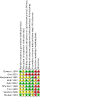
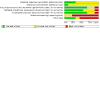
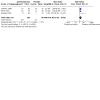

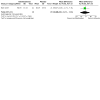
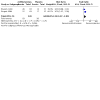


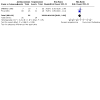
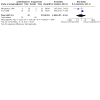
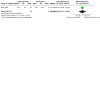


Update of
References
References to studies included in this review
Doweck 1994 {published data only}
-
- Doweck I, Gordon CR, Spitzer O, Melamed Y, Shupak A. Effect of cinnarizine in the prevention of seasickness. Aviation, Space, and Environmental Medicine 1994;65(7):606-9. - PubMed
Gao 2015 {published data only}
-
- Gao Y, Li X. Clinical research on motion sickness prevented and treated by spleen-strengthening and mind-refreshing acupuncture. Henan Traditional Chinese Medicine [Henan zhong yi] 2015;35(11):2842-3.
Hargreaves 1982 {published data only}
-
- Hargreaves J. The prophylaxis of seasickness: a comparison of cinnarizine with hyoscine. Practitioner 1982;226(1363):160. - PubMed
Kohl 1987 {published data only}
-
- Kohl RL, Homick JL, Cintron N, Calkins DS. Lack of effects of astemizole on vestibular ocular reflex, motion sickness, and cognitive performance in man. Aviation, Space, and Environmental Medicine 1987;58(12):1171-4. - PubMed
Muth 2007 {published data only}
-
- Muth ER, Elkins AN. High dose ondansetron for reducing motion sickness in highly susceptible subjects. Aviation Space & Environmental Medicine 2007;78(7):686-92. - PubMed
Offenloch 1986 {published data only}
-
- Offenloch K, Zahner G, Dietlein G, Franz I. Comparative in-flight study of a scopolamine-containing membrane plaster versus dimenhydrinate under defined acceleration conditions. Arzneimittel-Forschung 1986;36(9):1401-6. - PubMed
Price 1981 {published data only}
-
- Price NM, Schmitt LG, McGuire J, Shaw JE, Trobough G. Transdermal scopolamine in the prevention of motion sickness at sea. Clinical Pharmacology and Therapeutics 1981;29(3):414-9. - PubMed
Salenko 2006 {published data only}
-
- Salenko IuA, Barchukov VG, Sergeeva SA, Vorob'ev OA, Ponomarenko KV, Palamarchuk AM, et al. Pharmacoprophylaxis of sea-sickness syndrome with the help of homeopathic drug "Avia-more". Voenno-meditsinskii Zhurnal 2006;327(1):55-9, 96. - PubMed
Shupak 1994 {published data only}
-
- Shupak A, Doweck I, Gordon CR, Spitzer O. Cinnarizine in the prophylaxis of seasickness: laboratory vestibular evaluation and sea study. Clinical Pharmacology and Therapeutics 1994;55(6):670-80. - PubMed
References to studies excluded from this review
Alkaissi 2005 {published data only}
-
- Alkaissi A, Ledin T, Odkvist L M, Kalman S. P6 acupressure increases tolerance to nauseogenic motion stimulation in women at high risk for PONV. Canadian Journal of Anaesthesia-Journal Canadien D Anesthesie 2005;52(7):703-9. - PubMed
Bagian 1991 {published data only}
-
- Bagian JP. First intramuscular administration in the U.S. Space Program. Journal of Clinical Pharmacology 1991;31(10):920. - PubMed
Barber 1967 {published data only}
Becker 1984 {published data only}
-
- Becker G, Goossens H, Seemann K, Souchon F, Weitz T, Seeman K, et al. Prevention of motion sickness with a transdermal therapeutic system containing scopolamine. A randomized, comparative double-blind study in the German Federal Navy. Deutsche Medizinische Wochenschrift 1984;109(49):1881-5. - PubMed
Brand 1967 {published data only}
Brandt 1974 {published data only}
-
- Brandt T, Dichgans J, Wagner W. Drug effectiveness on experimental optokinetic and vestibular motion sickness. Aerospace Medicine 1974;45(11):1291-7. - PubMed
Brandt 1976 {published data only}
-
- Brandt T. Optico-vestibular motion disease, altitude vertigo and clinical forms of vertigo. Fortschritte der Medizin 1976;94(20-1):1177-82. - PubMed
Buckey 2004 {published data only}
-
- Buckey JC, Alvarenga D, Cole B, Rigas JR. Chlorpheniramine for motion sickness. Journal of Vestibular Research 2004;14(1):53-61. - PubMed
Buckey 2007 {published data only}
-
- Buckey JC, Alvarenga DL, MacKenzie TA. Chlorpheniramine and ephedrine in combination for motion sickness. Journal of Vestibular Research 2007;17(5-6):301-11. - PubMed
Chen 1992 {published data only}
-
- Chen KJ, Li CS, Zhang GX. Clinical and experimental studies of royal made ping an dan on treatment of motion sickness. Zhongguo Zhong Xi Yi Jie He Za Zhi Zhongguo Zhongxiyi Jiehe Zazhi/Chinese Journal of Integrated Traditional & Western Medicine/Zhongguo Zhong Xi Yi Jie He Xue Hui, Zhongguo Zhong Yi Yan Jiu Yuan Zhu Ban 1992;12(8):469-72, 452. - PubMed
Cheung 2003 {published data only}
-
- Cheung BS, Heskin R, Hofer KD. Failure of cetirizine and fexofenadine to prevent motion sickness. Annals of Pharmacotherapy 2003;37(2):173-7. - PubMed
Cheung 2011 {published data only}
-
- Cheung B, Nakashima AM, Hofer KD. Various anti-motion sickness drugs and core body temperature changes. Aviation, Space, and Environmental Medicine 2011;82(4):409-15. - PubMed
Chuk 1994 {published data only}
-
- Chuk MI. Study of pharmaceuticals for treating vestibular autonomous disturbances. Aviakosmicheskaya i Ecologicheskaya Meditsina 1994;28:11-4.
Cowings 1996 {published data only}
-
- Cowings PS, Stout C, Toscano WB, Reynoso S, DeRoshia C. The effects of promethazine on human performance, mood states, and motion sickness tolerance. NASA Technical Memorandum 110420. Available from: https://ntrs.nasa.gov/citations/19970004934 1996.
Cowings 2000 {published data only}
-
- Cowings PS, Toscano WB. Autogenic-feedback training exercise is superior to promethazine for control of motion sickness symptoms. Journal of Clinical Pharmacology 2000;40(10):1154-65. - PubMed
Dahl 1984 {published data only}
-
- Dahl E, Offer-Ohlsen D, Lillevold PE, Sandvik L. Transdermal scopolamine, oral meclizine, and placebo in motion sickness. Clinical Pharmacology and Therapeutics 1984;36(1):116-20. - PubMed
Dai 2003 {published data only}
-
- Dai M, Kunin M, Raphan T, Cohen B. The relation of motion sickness to the spatial-temporal properties of velocity storage. Experimental Brain Research. Experimentelle Hirnforschung. Experimentation cerebrale 2003;151(2):173-89. - PubMed
Davis 1992 {published data only}
-
- Davis JR, Jennings RT, Beck BG. Comparison of treatment strategies for space motion sickness. Microgravity Quarterly 1992;2(3):173-7. - PubMed
Davis 1993 {published data only}
-
- Davis JR, Jennings RT, Beck BG, Bagian JP. Treatment efficacy of intramuscular promethazine for space motion sickness. Aviation Space & Environmental Medicine 1993;64(3 Pt 1):230-3. - PubMed
Deane 1967 {published data only}
-
- Deane FR, Wood CD, Graybiel A, Graybiel A . Effect of drugs in altering susceptibility to motion sickness in aerobatics and the slow rotation room. Aerospace Medicine 1967;38(8):842-5. - PubMed
Digregorio 1978 {published data only}
-
- Digregorio GJ. Antivertigo and antimotion sickness drugs. American Family Physician 1978;18(6):130-2. - PubMed
Dolmierski 1983 {published data only}
-
- Dolmierski R. Seasickness treatment with cinnarizine. Bulletin of the Institute of Maritime and Tropical Medicine in Gdynia 1983;34(3-4):215-6. - PubMed
Dornhoffer 2004 {published data only}
-
- Dornhoffer J, Chelonis JJ, Blake D. Stimulation of the semicircular canals via the rotary chair as a means to test pharmacologic countermeasures for space motion sickness. Otology & Neurotology 2004;25(5):740-5. - PubMed
Dzendolet 1964 {published data only}
-
- Dzendolet E. Effect of dramamine on the objective electrical vestibulogram. Perceptual and Motor Skills 1964;18:465-8. - PubMed
Estrada 2007 {published data only}
-
- Estrada A, LeDuc PA, Curry IP, Phelps SE, Fuller DR. Airsickness prevention in helicopter passengers. Aviation, Space, and Environmental Medicine 2007;78(4):408-13. - PubMed
Ferrotti 1970 {published data only}
-
- Ferrotti A. Therapeutic considerations on kinetoses. Minerva Medica 1970;61(28):1408-16. - PubMed
Fregly 1973 {published data only}
-
- Fregly AR, Smith MJ, Wood CD, Cramer DB. Effects of some antimotion sickness drugs and secobarbital on postural equilibrium functions at sea level and at 12,000 feet (simulated). Aerospace Medicine 1973;44(2):140-5. - PubMed
Galle 1988 {published data only}
-
- Galle RR, Gusakova GA, Sabaev VV, Galle NN. Evaluation of the effectiveness of drugs for prevention of motion sickness [Russian]. Kosmicheskaia Biologiia i Aviakosmicheskaia Meditsina 1988;22(4):90-4. - PubMed
Gandia 2006 {published data only}
-
- Gandia P, Saivin S, Le-Traon AP, Guell A, Houin G. Influence of simulated weightlessness on the intramuscular and oral pharmacokinetics of promethazine in 12 human volunteers. Journal of Clinical Pharmacology 2006;46(9):1008-16. - PubMed
Gay 1949 {published data only}
-
- Gay LN, Carliner PE. The prevention and treatment of motion sickness. I. Seasickness. Science (New York, N.Y.) 1949;109:359. - PubMed
Gil 2012 {published data only}
-
- Gil A, Nachum Z, Tal D, Shupak A. A comparison of cinnarizine and transdermal scopolamine for the prevention of seasickness in naval crew: a double-blind, randomized, crossover study. Clinical Neuropharmacology 2012;35(1):37-9. - PubMed
Glaser 1959 {published data only}
-
- Glaser EM, McCance RA. Effect of drugs on motion sickness produced by short exposures to artificial waves. Lancet 1959;1(7078):853-6. - PubMed
Gordon 2001 {published data only}
-
- Gordon CR, Gonen A, Nachum Z, Doweck I, Spitzer O, Shupak A. The effects of dimenhydrinate, cinnarizine and transdermal scopolamine on performance. Journal of Psychopharmacology 2001;15(3):167-72. - PubMed
Gordon 2003 {published data only}
-
- Gordon CR, Doweck I, Nachum Z, Gonen A, Spitzer O, Shupak A. Evaluation of betahistine for the prevention of seasickness: effect on vestibular function, psychomotor performance and efficacy at sea. Journal of Vestibular Research-Equilibrium & Orientation 2003;13(2-3):103-11. - PubMed
Graybiel 1975 {published data only}
-
- Graybiel A, Wood CD, Knepton J, Hoche JP, Perkins GF. Human assay of antimotion sickness drugs. Aviation Space & Environmental Medicine 1975;46(9):1107-18. - PubMed
Graybiel 1976 {published data only}
-
- Graybiel A, Knepton J, Shaw J. Prevention of experimental motion sickness by scopolamine absorbed through the skin. Aviation, Space, and Environmental Medicine 1976;47(10):1096-100. - PubMed
Graybiel 1977 {published data only}
-
- Graybiel A, Knepton J. Evaluation of a new antinauseant drug for the prevention of motion sickness. Aviation, Space, and Environmental Medicine 1977;48(9):867-71. - PubMed
Graybiel 1987 {published data only}
-
- Graybiel A, Lackner JR. Treatment of severe motion sickness with antimotion sickness drug injections. Aviation, Space, and Environmental Medicine 1987;58(8):773-6. - PubMed
Green 1973 {published data only}
-
- Green JA, Green. Effectivity of antimotion sickness drugs during artificial gravity simulations. Aerospace Medicine 1973;44(11):1255-60. - PubMed
Hargreaves 1980 {published data only}
-
- Hargreaves J. A double-blind placebo controlled study of cinnarizine in the prophylaxis of seasickness. Practitioner 1980;224(1343):547-50. - PubMed
Heggie 1968 {published data only}
Hordinsky 1982 {published data only}
-
- Hordinsky JR, Schwartz E, Beier J, Martin J, Aust G. Relative efficacy of the proposed Space Shuttle antimotion sickness medications. Acta Astronautica 1982;9(6-7):375-83. - PubMed
Horing 2013 {published data only}
-
- Horing B, Weimer K, Schrade D, Muth ER, Scisco JL, Enck P, et al. Reduction of motion sickness with an enhanced placebo instruction: an experimental study with healthy participants. Psychosomatic Medicine 2013;75(5):497-504. - PubMed
Hu 1999 {published data only}
-
- Hu HQ, Jiang ZL, Zou GG. Observation of the seasickness prophylactic effect of pulvis zingiber siccus. Chinese Journal of Nautical Medicine 1999;6(1):23-5.
Jianping 2005 {published data only}
-
- Jianping H, Mingfang H, Xiquan Y. Clinical observation of the sea-sickness prophylactic effect of “anti-sick syrup” and “prevent-sick syrup”. Medical Journal of Chinese People's Liberation Army 2005;12.
Johnson 1976 {published data only}
-
- Johnson WH, Money KE, Graybiel A. Airborne testing of three antimotion sickness preparations. Aviation, Space, and Environmental Medicine 1976;47(11):1214-6.
Karmali 2016 {published data only}
-
- Karmali F, Artiles AD, Garza RG, Clark TK, Sherwood DP, Young LR. Development of a countermeasure to enhance sensorimotor adaptation to altered gravity levels. In: 2016 IEEE Aerospace Conference, 2016 Mar 5-12. 2016:1-7.
Klocker 2001 {published data only}
-
- Klocker N, Hanschke W, Toussaint S, Verse T, Kloecker N. Scopolamine nasal spray in motion sickness: a randomised, controlled, and crossover study for the comparison of two scopolamine nasal sprays with oral dimenhydrinate and placebo. European Journal of Pharmaceutical Sciences 2001;13(2):227-32. - PubMed
Kohl 1991 {published data only}
-
- Kohl RL, Calkins DS, Robinson RE. Control of nausea and autonomic dysfunction with terfenadine, a peripherally acting antihistamine. Aviation, Space, and Environmental Medicine 1991;62(5):392-6. - PubMed
Lackner 1994 {published data only}
-
- Lackner JR, Graybiel A. Use of promethazine to hasten adaptation to provocative motion. Journal of Clinical Pharmacology 1994;34(6):644-8. - PubMed
Lee 1986 {published data only}
-
- Lee JA, Watson LA, Boothby G. Calcium antagonists in the prevention of motion sickness. Aviation, Space, and Environmental Medicine 1986;57(1):45-8. - PubMed
Lucertini 2007 {published data only}
-
- Lucertini M, Mirante N, Casagrande M, Trivelloni P, Lugli V. The effect of cinnarizine and cocculus indicus on simulator sickness. Physiology & Behavior 2007;91(1):180-90. - PubMed
Macnair 1983 {published data only}
-
- Macnair AL. Cinnarizine in the prophylaxis of car sickness in children. Current Medical Research & Opinion 1983;8(7):451-5. - PubMed
Matsnev 2007 {published data only}
-
- Matsnev EI, Sigaleva EE. Efficacy of histaminergic drugs in experimental motion sickness. Journal of Vestibular Research-Equilibrium & Orientation 2007;17(5-6):313-21. - PubMed
May 1965 {published data only}
-
- May W. The treatment of seasickness with Kinetosin. Deutsche Gesundheitswesen 1965;20(27):1234-6. - PubMed
McCauley 1979 {published data only}
-
- McCauley ME, Royal JW, Shaw JE, Schmitt LG. Effect of transdermally administered scopolamine in preventing motion sickness. Aviation, Space, and Environmental Medicine 1979;50(11):1108-11. - PubMed
McClure 1982 {published data only}
-
- McClure JA, Lycett P, Baskerville JC. Diazepam AS an anti-motion sickness drug. Journal of Otolaryngology 1982;11(4):253-9. - PubMed
McMurray 1973 {published data only}
-
- McMurray GN. An evaluation of metoclopramide as an anti-emetic in seasickness. Postgraduate Medical Journal 1973;49 Suppl 4:38-41. - PubMed
Mowrey 1982 {published data only}
-
- Mowrey DB, Clayson DE. Motion sickness, ginger, and psychophysics. Lancet 1982;1(8273):655-7. - PubMed
Muth 1995a {published data only}
-
- Muth ER, Jokerst M, Stern RM, Koch KL. Effects of dimenhydrinate on gastric tachyarrhythmia and symptoms of vection-induced motion sickness. Aviation, Space, and Environmental Medicine 1995;66(11):1041-5. - PubMed
Nachum 2001 {published data only}
-
- Nachum Z, Shahal B, Shupak A, Spitzer O, Gonen A, Beiran I, et al. Scopolamine bioavailability in combined oral and transdermal delivery. Journal of Pharmacology and Experimental Therapeutics 2001;296(1):121-3. - PubMed
NCT02177890 2014 {published data only}
-
- NCT02177890. Effect of transcutaneous vagal nerve stimulation on reducing visually induced motion sickness in healthy volunteers. https://clinicaltrials.gov/ct2/show/NCT02177890 (first received 30 June 2014).
NCT02241629 2014 {published data only}
-
- NCT02241629. Levo phencynonate hydrochloride for the prevention of seasickness. https://clinicaltrials.gov/ct2/show/NCT02241629 (first received 16 September 2014).
Noy 1984 {published data only}
-
- Noy S, Shapira S, Zilbiger A, Ribak J. Transdermal therapeutic system scopolamine (TTSS), dimenhydrinate, and placebo. A comparative study at sea. Aviation, Space, and Environmental Medicine 1984;55(11):1051-4. - PubMed
Oosterveld 1965 {published data only}
-
- Oosterveld WJ, Zelig S. Effects of a combination of chlorcyclizine hydrochloride and cinnarizine on the linear acceleration test. Acta Physiologica et Pharmacologica Neerlandica 1965;13(3):348-54. - PubMed
Otto 2006 {published data only}
Palmer 1950 {published data only}
-
- Palmer JM. Dramamine and sea-sickness [letter]. British Medical Journal 1950;2(4685):946-7.
Pingree 1989 {published data only}
-
- Pingree BJW, Pethybridge RJ. A double-blind placebo-controlled comparison of hyoscine with early administered cinnarizine in increasing tolerance to a nauseogenic cross-coupled motion challenge. Pharmaceutical Medicine 1989;4(1):29-42.
Pingree 1994 {published data only}
-
- Pingree BJ, Pethybridge RJ. A comparison of the efficacy of cinnarizine with scopolamine in the treatment of seasickness. Aviation, Space, and Environmental Medicine 1994;65(7):597-605. - PubMed
Putcha 1999 {published data only}
-
- Putcha L, Berens KL, Marshburn TH, Ortega HJ, Billica RD. Pharmaceutical use by U.S. astronauts on space shuttle missions. Aviation Space & Environmental Medicine 1999;70(7):705-8. - PubMed
Pyykko 1984 {published data only}
-
- Pyykkö I, Schalén L, Jäntti V, Magnusson M. A reduction of vestibulo-visual integration during transdermally administered scopolamine and dimenhydrinate. A presentation of gain control theory in motion sickness. Acta Oto-laryngologica. Supplementum 1984;406(8):167-73. - PubMed
Pyykko 1985 {published data only}
-
- Pyykko I, Schalen L, Jantti V, Pyykko I, Schalen L, Matsuoka I. Transdermally administered scopolamine vs. dimenhydrinate. I. Effect on nausea and vertigo in experimentally induced motion sickness. Acta Oto-Laryngologica (Stockholm) 1985;99(5-6):588-96. - PubMed
Reicke 1976 {published data only}
-
- Reicke N. The etiology and drug therapy of kinesia: investigations by means of the coriolis effect under cyclizine. ORL; Journal for Oto-rhino-laryngology and Its Related Specialties 1976;38(5):267-75. - PubMed
Reimann 1981 {published data only}
-
- Reimann HJ, Erbel F, Bergemann B. Progress in treatment of motion sickness: a chewing-gum containing dimenhydrinate [German]. Therapie der Gegenwart 1981;120(12):1171-80. - PubMed
Ressiot 2013 {published data only}
-
- Ressiot E, Dolz M, Bonne L, Marianowski R. Prospective study on the efficacy of optokinetic training in the treatment of seasickness. European Annals of Otorhinolaryngology, Head and Neck Diseases 2013;130(5):263-8. - PubMed
Scherer 1980 {published data only}
-
- Scherer H, Bschorr J. Considerations about methods to test the effectiveness of anti-vertiginous drugs (author's transl). Laryngologie, Rhinologie, Otologie 1980;59(8):477-84. - PubMed
Schmid 1994 {published data only}
-
- Schmid R, Schick T, Steffen R, Tschopp A, Wilk T. Comparison of seven commonly used agents for prophylaxis of seasickness. Journal of Travel Medicine 1994;1(4):203-6. - PubMed
Seibel 2005 {published data only}
-
- Seibel K, Schaffler K, Reitmeir P, Golly I. Erratum: A randomised, placebo-controlled study comparing two formulations of dimenhydrinate with respect to efficacy in motion sickness and sedation (Arzneimittel-Forschung/Drug Research (2005) 52, 7 (529-536)). Arzneimittel-Forschung/Drug Research 2005;55(5):301. - PubMed
Shabanov 2005 {published data only}
-
- Shabanov PD, Anokhin AG. Evaluation of anti-seasick properties of pyrroxan and dimenhydrinate under conditions of maximal and submaximal statokinetic load in humans [Russian]. Eksperimental'naya i Klinicheskaya Farmakologiya 2005;68(3):50-5. - PubMed
Shashkov 1981 {published data only}
-
- Shashkov VS, Sabaev VV. Pharmacologic agents for preventing and treating motion sickness. Kosmicheskaia Biologiia i Aviakosmicheskaia Meditsina 1981;15(1):9-18. - PubMed
Shashkov 1999 {published data only}
-
- Shashkov VS, Kotovskaia AR, Orlov OI, Koloteva MI, Shashkov AV, Karsanova SK. An experimental validation of pharmacological agents to arrest the vestibulo-autonomic syndrome (motion sickness). Eksperimentalnaia i Klinicheskaia Farmakologiia 1999;62(6):11-5. - PubMed
Shete 2015 {published data only}
Stewart 2000 {published data only}
-
- Stewart JJ, Wood MJ, Parish RC, Wood CD. Prokinetic effects of erythromycin after antimotion sickness drugs. Journal of Clinical Pharmacology 2000;40(4):347-53. - PubMed
Stockhorst 2014 {published data only}
-
- Stockhorst U, Hall G, Enck P, Klosterhalfen S. Effects of overshadowing on conditioned and unconditioned nausea in a rotation paradigm with humans. Experimental Brain Research 2014;232(8):2651-64. - PubMed
Stott 1984 {published data only}
-
- Stott JRR, Hubble MP, Spencer MB, Royal Air Force Farnborough Institute of Aviation Medicine. A double blind comparative trial of powdered ginger root, hyosine hydrobromide, and cinnarizine in the prophylaxis of motion sickness induced by cross coupled stimulation. https://apps.dtic.mil/sti/citations/ADP004651 1984.
Strickland 1949 {published data only}
-
- Strickland BA, Hahn GL. The effectiveness of dramamine in the prevention of airsickness. Science (New York, NY) 1949;109:359-60. - PubMed
Sugano 1977 {published data only}
-
- Sugano H, Tominaga H. Evaluation of anti-motion sickness drugs by body responses to labyrinthine stimulation. Agressologie 1977;18 Spec No:63-7. - PubMed
Sunahara 1987 {published data only}
-
- Sunahara FA, Farewell J, Mintz L, Johnson WH. Pharmacological interventions for motion sickness: cardiovascular effects. Aviation, Space, and Environmental Medicine 1987;58(9 Pt 2):A270-6. - PubMed
Sutton 2012 {published data only}
-
- Sutton M, Mounsey AL, Russell RG. FPIN's Clinical Inquiries. Treatment of motion sickness. American Family Physician 2012;86(2):192-5. - PubMed
Towse 1980 {published data only}
-
- Towse G. Cinnarizine--a labyrinthine sedative. Journal of Laryngology & Otology 1980;94(9):1009-15. - PubMed
Trumbull 1960 {published data only}
-
- Trumbull R, Chinn HI, Maag CH, Milch LJ, Handford SW, Seibert R, et al. Effect of certain drugs on the incidence of seasickness. Clinical Pharmacology and Therapeutics 1960;1(3):280-3. - PubMed
Van Driessche 1985 {published data only}
-
- Van Driessche R. A combination of cinnarizine and domperidone for the prevention of motion sickness: a double-blind comparative study versus cinnarizine against seasickness. Current Therapeutic Research, Clinical and Experimental 1985;38(1):61-7.
van Oosterhout 2015 {published data only}
-
- Oosterhout WPJ, Terwindt GM, Vein AA, Ferrari MD. Space headache on Earth: head-down-tilted bed rest studies simulating outer-space microgravity. Cephalalgia 2015;35(4):335-43. - PubMed
Vigliano 1987 {published data only}
-
- Vigliano R, Cirillo V, Sabato F, Cattoni M, Cattoni M. Prevention of sea sickness with transdermal scopolamine, dimenhydrinate and a placebo. Gazzetta Medica Italiana Archivio per le Scienze Mediche 1987;146(9):391-4.
von Lieven 1970 {published data only}
-
- Lieven T. Symptom genesis and therapy of travel sickness. Experimentally produced motion sicknesses and the effect of dimenhydrate (Novomina). Munchener Medizinische Wochenschrift 1970;112(43):1953-9. - PubMed
von Lieven 1971 {published data only}
-
- Lieven T, Voigt K. Comparative studies on the effect of two antimetics in experimental kinetoses. Medizinische Klinik 1971;66(32):1089-93. - PubMed
Wang 2012 {published data only}
-
- Wang Z, Lee B, Pearce D, Qian S, Wang Y, Zhang Q, et al. Meclizine metabolism and pharmacokinetics: formulation on its absorption. Journal of Clinical Pharmacology 2012;52(9):1343-9. - PubMed
Weerts 2013 {published data only}
-
- Weerts AP, Vanspauwen R, Fransen E, Jorens PG, Van de Heyning PH, Wuyts FL. Baclofen affects the semicircular canals but not the otoliths in humans. Acta Oto-Laryngologica 2013;133(8):846-52. - PubMed
Weichenthal 2009 {published data only}
-
- Weichenthal LA, Andrews J, Rubio S. The treatment of motion sickness in the out-of-hospital setting: a comparison of metoclopramide and diphenhydramine to placebo. Annals of Emergency Medicine 2009;54(3):S36.
Weimer 2012 {published data only}
Weimer 2014 {published data only}
Weinstein 1997 {published data only}
-
- Weinstein SE, Stern RM. Comparison of marezine and dramamine in preventing symptoms of motion sickness. Aviation, Space, and Environmental Medicine 1997;68(10):890-4. - PubMed
Wood 1965 {published data only}
-
- Wood CD, Graybiel A, Kennedy RS. A comparison of effectiveness of some antimotion sickness drugs using recommended and larger than recommended doses as tested in the slow rotation room. NSAM-945. Research Report/United States 1965;Naval School of Aviation Medicine:1-9. - PubMed
Wood 1968 {published data only}
-
- Wood CD, Graybiel A. Evaluation of sixteen anti-motion sickness drugs under controlled laboratory conditions. Aerospace Medicine 1968;39(12):1341-4. - PubMed
Wood 1970a {published data only}
-
- Wood CD, Graybiel A. Evaluation of antimotion sickness drugs: a new effective remedy revealed. Aerospace Medicine 1970;41(8):932-3. - PubMed
Wood 1979 {published data only}
-
- Wood CD. Antimotion sickness and antiemetic drugs. Drugs 1979;17(6):471-9. - PubMed
Wood 1981 {published data only}
-
- Wood CD, Cramer DB, Graybiel A. Antimotion sickness drug efficacy. Otolaryngology - Head & Neck Surgery 1981;89(6):1041-4. - PubMed
Wood 1988 {published data only}
-
- Wood CD, Manno JE, Wood MJ, Manno BR, Mims ME. Comparison of efficacy of ginger with various antimotion sickness drugs. Clinical Research Practices and Drug Regulatory Affairs 1988;6(2):129-36. - PubMed
Wood 1990 {published data only}
-
- Wood CD, Stewart JJ, Wood MJ, Manno JE, Manno BR, Mims ME. Therapeutic effects of antimotion sickness medications on the secondary symptoms of motion sickness. Aviation, Space, and Environmental Medicine 1990;61(2):157-61. - PubMed
Wood 1992 {published data only}
-
- Wood CD, Stewart JJ, Wood MJ, Mims M. Effectiveness and duration of intramuscular antimotion sickness medications. Journal of Clinical Pharmacology 1992;32(11):1008-12. - PubMed
Yun‐long 2001 {published data only}
-
- Yun-long Deng, Yong-mei Zhang. Study on the efficacy of phencynonate hydrochloride tablets in prevention of motion sickness. Chinese New Drugs Journal 2001;6(020):453-4.
Additional references
Bertolini 2016
Bles 1998
-
- Bles W, Bos JE, Graaf B, Groen E, Wertheim AH. Motion sickness: only one provocative conflict? Brain Research Bulletin 1998;47(5):481-7. - PubMed
Brainard 2014
-
- Brainard A, Gresham C. Prevention and treatment of motion sickness. American Family Physician 2014;90(1):41-6. - PubMed
Cevette 2014
-
- Cevette MJ, Pradhan GN, Cocco D, Crowell MD, Galea AM, Bartlett J, et al. Electrogastrographic and autonomic responses during oculovestibular recoupling in flight simulation. Aviation, Space, and Environmental Medicine 2014;85(1):15-24. - PubMed
Chang 2013
-
- Chang CH, Pan WW, Chen FC, Stoffregen TA. Console video games, postural activity, and motion sickness during passive restraint. Experimental Brain Research 2013;229(2):235. - PubMed
Chu 2012
-
- Chu H, Li MH, Juan SH, Chiou WY. Effects of transcutaneous electrical nerve stimulation on motion sickness induced by rotary chair: a crossover study. Journal of Alternative and Complementary Medicine 2012;18(5):494-500. - PubMed
Cohen 2003
-
- Cohen B, Dai M, Raphan T. The critical role of velocity storage in production of motion sickness. Annals of the New York Academy of Sciences 2003;1004:359-76. - PubMed
Cowings 1986
-
- Cowings PS, Suter S, Toscano WB, Kamiya J, Naifeh K. General autonomic components of motion sickness. Psychophysiology 1986;23(5):542-51. - PubMed
Diels 2016
-
- Diels C, Bos JE. Self-driving carsickness. Applied Ergonomics 2016;53 Pt B:374-82. - PubMed
Dong 2011
-
- Dong X, Yoshida K, Stoffregen TA. Control of a virtual vehicle influences postural activity and motion sickness. Journal of Experimental Psychology: Applied 2011;17(2):128. - PubMed
Förstberg 1998
-
- Förstberg J, Andersson E, Ledin T. Influence of different conditions for tilt compensation on symptoms of motion sickness in tilting trains. Brain Research Bulletin 1998;47(5):525-35. - PubMed
Gianaros 2001
Golding 1998
-
- Golding JF. Motion sickness susceptibility questionnaire revised and its relationship to other forms of sickness. Brain Research Bulletin 1998;47(5):507-16. - PubMed
Golding 2015
-
- Golding JF, Gresty MA. Pathophysiology and treatment of motion sickness. Current Opinion in Neurology 2015;28(1):83-8. - PubMed
Graybiel 1968
-
- Graybiel A, Wood CD, Miller EF, Cramer DB. Diagnostic criteria for grading the severity of acute motion sickness. Aerospace Medicine 1968;39(5):453-5. - PubMed
Henriques 2014
-
- Henriques IF, Douglas de Oliveira DW, Oliveira-Ferreira F, Andrade PM. Motion sickness prevalence in school children. European Journal of Pediatrics 2014;173(11):1473-82. - PubMed
Higgins 2011
-
- Higgins JPT, Green S (editors). Cochrane Handbook for Systematic Reviews of Interventions Version 5.1.0 [updated March 2011]. The Cochrane Collaboration, 2011. Available from www.cochrane-handbook.org.
Hippocrates
-
- Aphorisms By Hippocrates Written 400 B.C.E (Translated by Francis Adams), Section IV, 14. http://classics.mit.edu/Hippocrates/aphorisms.html (accessed 10 July 2016).
Holly 1996
-
- Holly JE, McCollum G. The shape of self-motion perception—II. Framework and principles for simple and complex motion. Neuroscience 1996;70(2):487-513. - PubMed
Keshavarz 2014
-
- Keshavarz B, Hecht H. Pleasant music as a countermeasure against visually induced motion sickness. Applied Ergonomics 2014;45(3):521-7. - PubMed
Kohl 1985
-
- Kohl RL. Endocrine correlates of susceptibility to motion sickness. Aviation, Space, and Environmental Medicine 1985;56(12):1158-65. - PubMed
Leung 2019
Lien 2003
-
- Lien HC, Sun WM, Chen YH, Kim H, Hasler W, Owyang C. Effects of ginger on motion sickness and gastric slow-wave dysrhythmias induced by circular vection. American Journal of Physiology-Gastrointestinal and Liver Physiology 2003;284(3):G481-9. - PubMed
Mahdy 2014
-
- Mahdy AM, Webster NR. Histamine and antihistamines. Anaesthesia & Intensive Care Medicine 2014;15(5):250-5.
Matsangas 2014
-
- Matsangas P, McCauley ME, Becker W. The effect of mild motion sickness and sopite syndrome on multitasking cognitive performance. Human Factors 2014;56(6):1124-35. - PubMed
Murdin 2011
-
- Murdin L, Golding J, Bronstein A. Managing motion sickness. BMJ 2011;343:d7430. - PubMed
Murdin 2015
Muth 1995b
-
- Muth ER, Stern RM, Thayer JF, Koch KL. Assessment of the multiple dimensions of nausea: the nausea profile. Journal of Psychosomatic Research 1995;40:511-20. - PubMed
Nishiike 2013
-
- Nishiike S, Okazaki S, Watanabe H, Akizuki H, Imai T, Uno A, et al. The effect of visual-vestibulosomatosensory conflict induced by virtual reality on postural stability in humans. Journal of Medical Investigation 2013;60(3-4):236-9. - PubMed
Oman 1990
-
- Oman CM. Motion sickness: a synthesis and evaluation of the sensory conflict theory. Canadian Journal of Physiology and Pharmacology 1990;68(2):294-303. - PubMed
Paillard 2013
-
- Paillard AC, Quarck G, Paolino F, Denise P, Paolino M, Golding JF, et al. Motion sickness susceptibility in healthy subjects and vestibular patients: effects of gender, age and trait-anxiety. Journal of Vestibular Research 2013;23(4, 5):203-9. - PubMed
Perrin 2013
-
- Perrin P, Lion A, Bosser G, Gauchard G, Meistelman C. Motion sickness in rally car co-drivers. Aviation, Space, and Environmental Medicine 2013;84(5):473-7. - PubMed
Reason 1978
Reavley 2006
-
- Reavley CM, Golding JF, Cherkas LF, Spector TD, MacGregor AJ. Genetic influences on motion sickness susceptibility in adult women: a classical twin study. Aviation, Space, and Environmental Medicine 2006;77(11):1148-52. - PubMed
RevMan 2020 [Computer program]
-
- Review Manager (RevMan). Version 5.4. Copenhagen: The Nordic Cochrane Centre, The Cochrane Collaboration, 2020.
Schutz 2014
-
- Schutz L, Zak D, Holmes JF. Pattern of passenger injury and illness on expedition cruise ships to Antarctica. Journal of Travel Medicine 2014;21(4):228-34. - PubMed
Sharon 2014
Simons 2004
-
- Simons F, Estelle R. Advances in H1-antihistamines. New England Journal of Medicine 2004;351(21):2203-17. - PubMed
Solimini 2013
Soto 2010
Spinks 2011
Stoffregen 2008
-
- Stoffregen TA, Faugloire E, Yoshida K, Flanagan MB, Merhi O. Motion sickness and postural sway in console video games. Human Factors 2008;50(2):322-31. - PubMed
Stoffregen 2013
Tal 2010
-
- Tal D, Bar R, Nachum Z, Gil A, Shupak A. Postural dynamics and habituation to seasickness. Neuroscience Letters 2010;479(2):134-7. - PubMed
Tal 2012
-
- Tal D, Gonen A, Wiener G, Bar R, Gil A, Nachum Z, et al. Artificial horizon effects on motion sickness and performance. Otology & Neurotology 2012;33:878Y885. - PubMed
Tal 2013
-
- Tal D, Hershkovitz D, Kaminski-Graif G, Wiener G, Samuel O, Shupak A. Vestibular evoked myogenic potentials and habituation to seasickness. Clinical Neurophysiology 2013;124(12):2445-9. - PubMed
Tanguy 2008
-
- Tanguy S, Quarck G, Etard O, Gauthier A, Denise P. Vestibulo-ocular reflex and motion sickness in figure skaters. European Journal of Applied Physiology 2008;104(6):1031-7. - PubMed
Thornton 2013
-
- Thornton WE, Bonato F. Space motion sickness and motion sickness: symptoms and etiology. Aviation, Space, and Environmental Medicine 2013;84(7):716-21. - PubMed
Wada 2015
-
- Wada T, Yoshida K. Effect of passengers’ active head tilt and opening/closure of eyes on motion sickness in lateral acceleration environment of cars. Ergonomics 2015 Dec 23 [Epub ahead of print]. - PubMed
Webb 2013
-
- Webb CM, Estrada A, Athy JR. Motion sickness prevention by an 8-Hz stroboscopic environment during air transport. Aviation, Space, and Environmental Medicine 2013;84(3):177-83. - PubMed
Weerts 2014a
-
- Weerts AP, Vanspauwen R, Fransen E, Jorens PG, Heyning PH, Wuyts FL. Space motion sickness countermeasures: a pharmacological double-blind, placebo-controlled study. Aviation, Space, and Environmental Medicine 2014;85(6):638-44. - PubMed
Weerts 2014b
-
- Weerts AP, Pattyn N, Van de Heyning PH, Wuyts FL. Evaluation of the effects of anti-motion sickness drugs on subjective sleepiness and cognitive performance of healthy males. Journal of Psychopharmacology 2014;28(7):655-64. - PubMed
Wiker 1979
-
- Wiker SF, Kennedy RS, McCauley ME, Pepper RL. Reliability, Validity and Application of an Improved Scale for Assessment of Motion Sickness Severity. Coast Guard Washington DC Office of Research and Development 1979.
Wood 1970b
-
- Wood CD, Graybiel A. A theory of motion sickness based on pharmacological reactions. Clinical Pharmacology & Therapeutics 1970;11(5):621-9. - PubMed
Woodard 1993
-
- Woodard D, Knox G, Myers KJ, Chelen W, Ferguson B. Phenytoin as a countermeasure for motion sickness in NASA maritime operations. Aviation, Space, and Environmental Medicine 1993;64(5):363-6. - PubMed
Yen Pik Sang 2005
-
- Yen Pik Sang F, Billar J, Gresty MA, Golding JF. Effect of a novel motion desensitization training regime and controlled breathing on habituation to motion sickness. Perceptual and Motor Skills 2005;101(1):244-56. - PubMed
Zajonc 2006
-
- Zajonc TP, Roland PS. Vertigo and motion sickness. Part II: Pharmacologic treatment. Ear, Nose, & Throat Journal 2006;85(1):25. - PubMed
Publication types
MeSH terms
Substances
LinkOut - more resources
Full Text Sources
Medical
Research Materials
Miscellaneous

